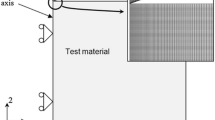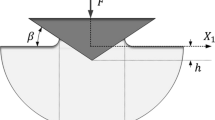Abstract
Theoretical analysis and finite element (FE) simulation have been carried out for a constant specific load rate (CSLR) indentation creep test. Analytical results indicate that both the representative stress and the indentation strain rate become constant after a transient period. Moreover, the FE simulation reveals that both the contours of equivalent stress and equivalent plastic strain rate underneath the indenter evolve with geometrical self-similarity. This suggests that pseudo-steady indentation creep occurs in the region beneath the indenter. The representative points in the region are defined as the ones with the equivalent stress equal to the representative stress. In addition, it is revealed that the proportionality between indentation strain rate and equivalent plastic strain rate holds at the representative points during the pseudo-steady indentation creep of a power law material. A control volume (CV) beneath the indenter, which governs the indenter velocity, is identified. The size of the CV at the indented surface is approximately 2.5 times the size of the impression. The stress exponent for creep can be obtained from the pseudo-steady indentation creep data. These results demonstrate that the CSLR testing technique can be used to evaluate creep parameters with the same accuracy as conventional uniaxial creep tests.
Similar content being viewed by others
References
Fujiwara, M., Characterization of mechanical properties in materials through instrumented indentation. Journal of Japan Institute of Light Metals, 2002, 52: 282–290.
Takagi, H., Dao, M., Fujiwara, M. and Otsuka. M., Experimental and computational creep characterization of Al-Mg solid-solution alloy through instrumented indentation. Philosophical Magazine, 2003, 83: 3959–3976.
Takagi, H., Dao, M., Fujiwara, M. and Otsuka, M., Creep characterization of aluminum-magnesium solid-solution alloy through self-similar microindentation. Materials Transact, 2006, 47: 2006–2014.
Pollock, H.M., Maugis, D. and Barquins, M., Microindentation Techniques in Materials Science and Engineering. Blau, P.J. and Lawn, B.R. eds, (ASTM, Philadelphia, 1986): 47–71.
Tabor, D., The Hardness of Metals. Oxford University Press, 1951.
Cheng, Y.T. and Cheng, C.M., Scaling relationships in indentation of power-law creep solids using self-similar indenters. Philosophical Magazine Letter, 2001, 81: 9–16.
Takagi, H. and Fujiwara, M., Creep characterization of power-law materials through pseudo-steady indentation tests. Materials Science Forum, 2007, 561–565: 2063–2066.
Author information
Authors and Affiliations
Rights and permissions
About this article
Cite this article
Takagi, H., Dao, M. & Fujiwara, M. Analysis on Pseudo-Steady Indentation Creep. Acta Mech. Solida Sin. 21, 283–288 (2008). https://doi.org/10.1007/s10338-008-0832-3
Received:
Revised:
Published:
Issue Date:
DOI: https://doi.org/10.1007/s10338-008-0832-3




